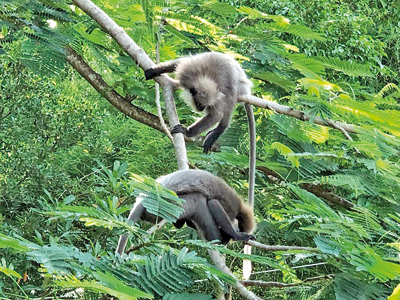Beautiful, yet troublesome foursome
Smash! Bang! Crash!
A tranquil green grove of a sleepy village in the Deep South is woken up. But the disturbance is so frequent, ears now don’t respond. The monkey menace is on!

Nut destroyer: The giant squirrel (top) and the toque monkey
We in the southern villages dread the grey langur in our gardens no less than the town folks dread the pole cat on their ceilings. The ghostly cats at least leave you at peace during the day. Here, the monkeys have become such a threat to the livelihoods of people, householders cannot relax especially if there is a cultivation at hand.
Small-time farmers who convert their gardens to fruit and vegetable plots are the most affected. A troupe of grey langur will need less than 30 minutes to go through a quarter acre plot of banana, mango, papaw, cucumber, snake gourd or bitter gourd. It is the same for a breadfruit or a cashew tree bearing well.
As such, farmers need to keep vigil. They are often armed with stones and sticks throughout the day to chase the langur away. Some animals have become crafty and get about crossing roofs at will to confuse the plot owners giving chase. Tiled roofs are at risk and even asbestos sheets at unsupported edges are known to crack from the force of the langur landing.
Some light crackers to scare them away but they return. Decades ago when guns were in distribution in villages there was some control over the issue. Now, many give up their cultivations, unable to bear the repeated destruction. Grey langur roost for the night on tall, spreading trees near water and breed rapidly both in the forests as well as in the well wooded villages. In the forests, the langur fall prey to leopards; the only predator they need to worry about. Elsewhere, village dogs are not kind to them if they happen to miss a hold on a leap.
To describe the monkey menace in the fewest possible words – they let 50 mangoes drop on the ground in their quest to consume just one ripe fruit. That’s the kind of devastation they bring about.

Invading home gardens: A peacock in full plumage and below, the grey langurs on the prowl
The giant squirrel is a lovely creature that lives among thick foliage. Usually arboreal, its shy nature and camouflaging colours makes it difficult to spot easily though its long bushy tail is often a giveaway. In the leafy village gardens, the giant squirrel is a major pest as it is so fond of young coconut-water that before the husk properly forms and hardens, with its sharp premolars, the squirrel pierces the coconut to make a hole big enough to insert its head into the inner hollow where the juice is found. It sucks it all out! Without the nourishing juice, the nut dies and falls off, revealing the sheared husk on a side with the distinct hole in the middle! The giant squirrels are also desperately attracted to malabar tamarind (goraka) and take up residence on a tree during the fruiting season.
The toque monkey does the same with a young coconut – more efficiently. They mostly do not stay long in one area but are the worst pest as they don’t spare even houses, stealthily creeping into kitchens and storage areas to feed on anything edible.
 Lastly, the gorgeous peacock brings about its own havoc in vegetable plots and rice fields. It is a grain feeder and when paddy is about to be harvested it will feed on the rice panicles, concealed among the ripened tillers, slurping the seeds out delicately. When paddy is laid to dry, peacocks feast on the spread lavishly. They will not even spare flowers of green chilies and, brinjals and what not and are often found moving among the plants unseen in large cultivations. They roost on lofty trees and roofs also, at times disarranging the tiles, and lay eggs on rooftops during the breeding season. Concrete surfaces seem ideal for the purpose. Peacocks breed fast and add numbers rapidly.
Lastly, the gorgeous peacock brings about its own havoc in vegetable plots and rice fields. It is a grain feeder and when paddy is about to be harvested it will feed on the rice panicles, concealed among the ripened tillers, slurping the seeds out delicately. When paddy is laid to dry, peacocks feast on the spread lavishly. They will not even spare flowers of green chilies and, brinjals and what not and are often found moving among the plants unseen in large cultivations. They roost on lofty trees and roofs also, at times disarranging the tiles, and lay eggs on rooftops during the breeding season. Concrete surfaces seem ideal for the purpose. Peacocks breed fast and add numbers rapidly.
The villagers of Sri Lanka steer shy of causing any serious harm to these eye-catching specimens due to religious and cultural sentiments and usually swallow their losses grinding their teeth.
Yet looking at the big picture, it is no secret the pests are a threat to the national production. It is high time the authorities act wisely and find scientific ways to stall breeding as a long-term solution to the problem. They can research on how other nations have overcome the curse brought about to village life by this beautiful yet troublesome foursome.
Searching for an ideal partner? Find your soul mate on Hitad.lk, Sri Lanka's favourite marriage proposals page. With Hitad.lk matrimonial advertisements you have access to thousands of ads from potential suitors who are looking for someone just like you.


